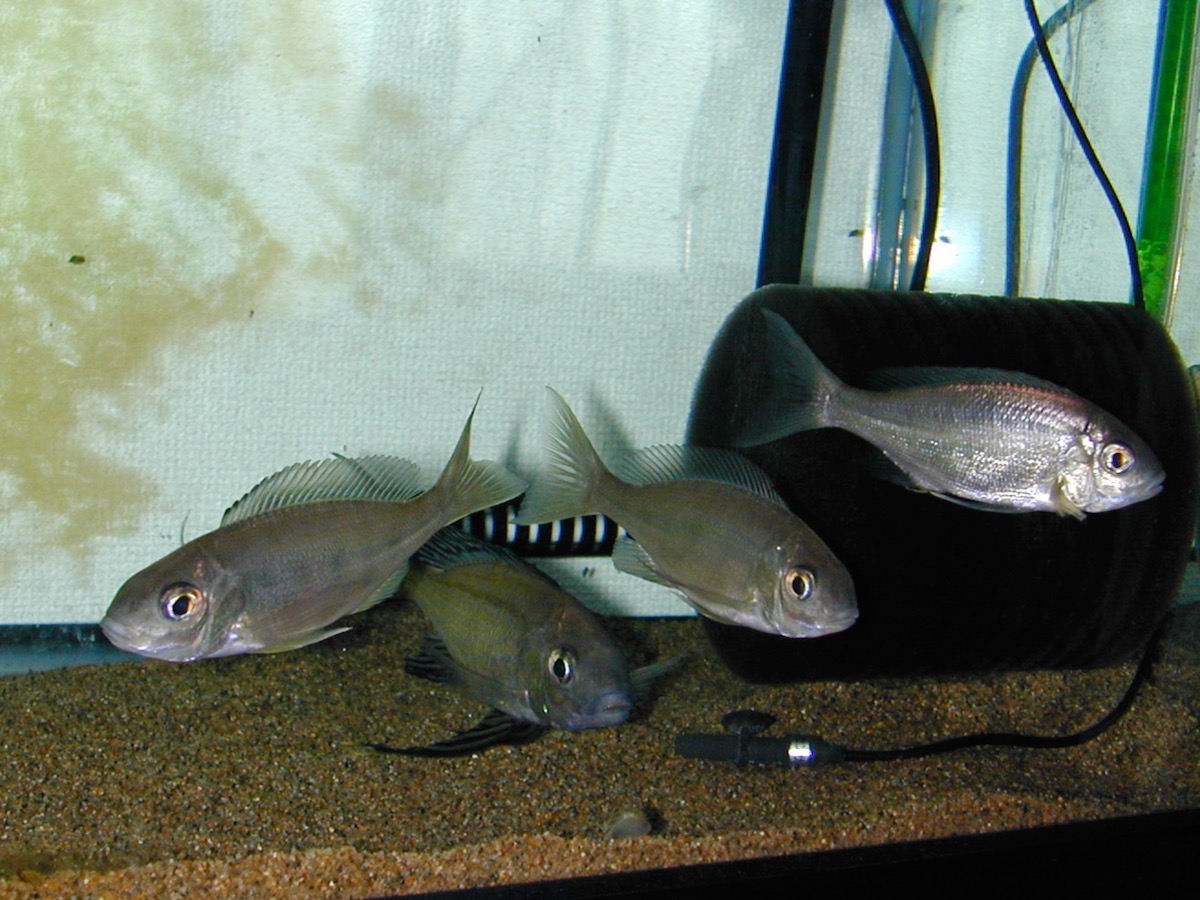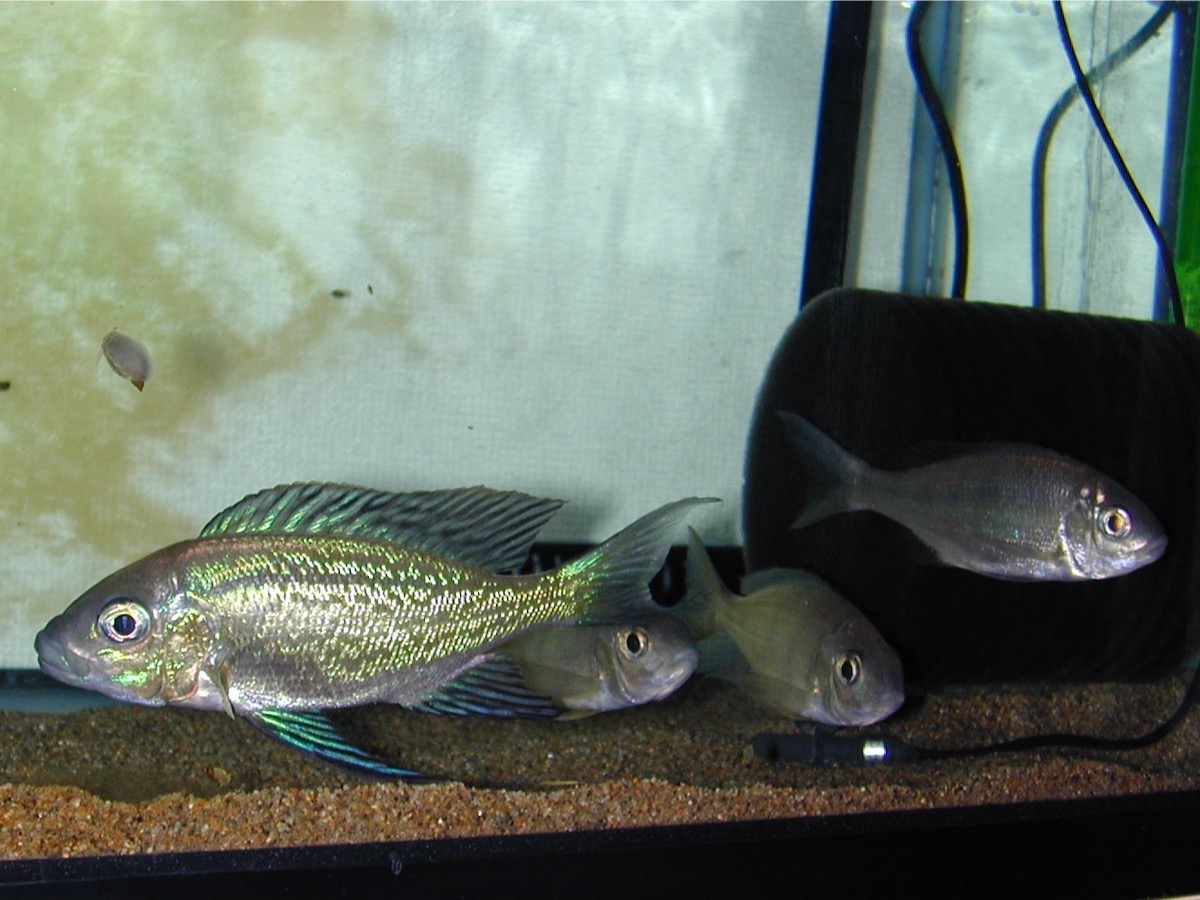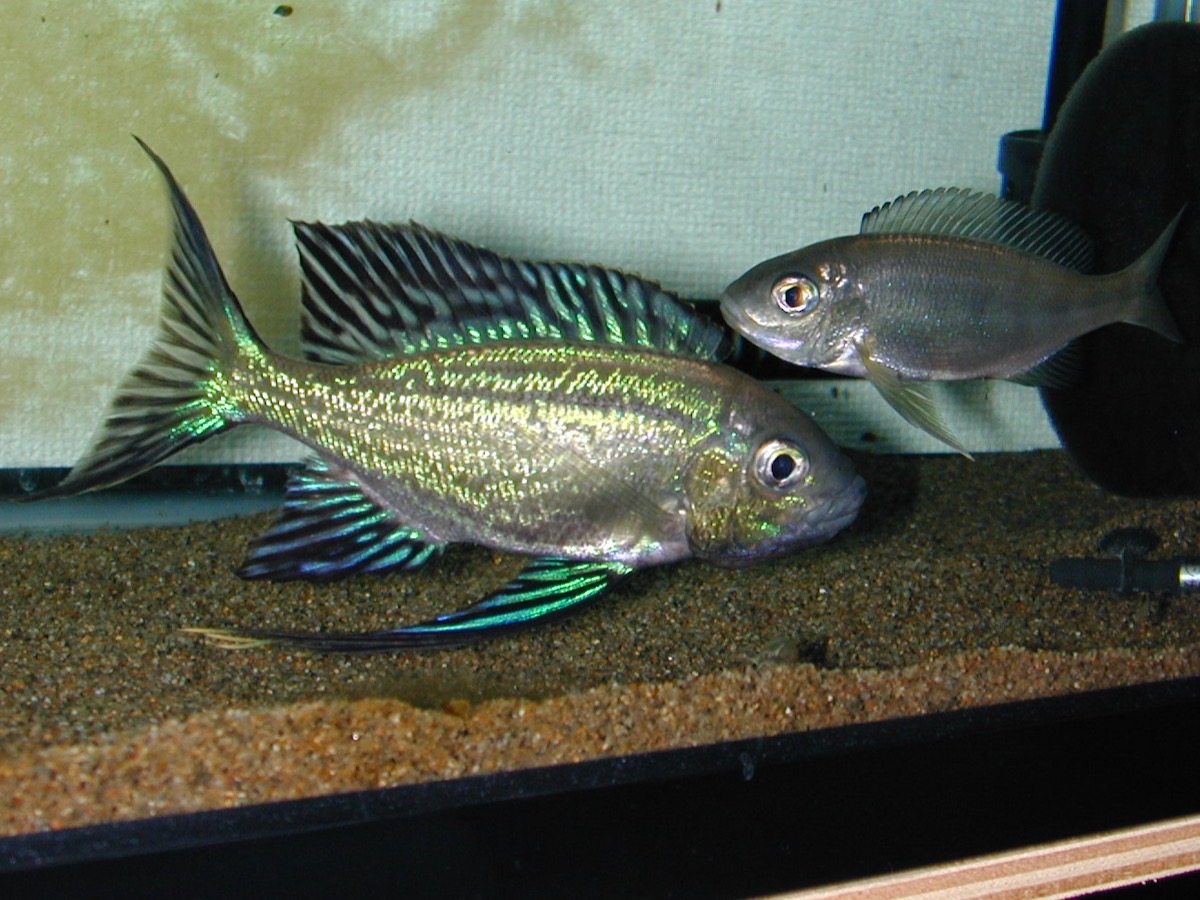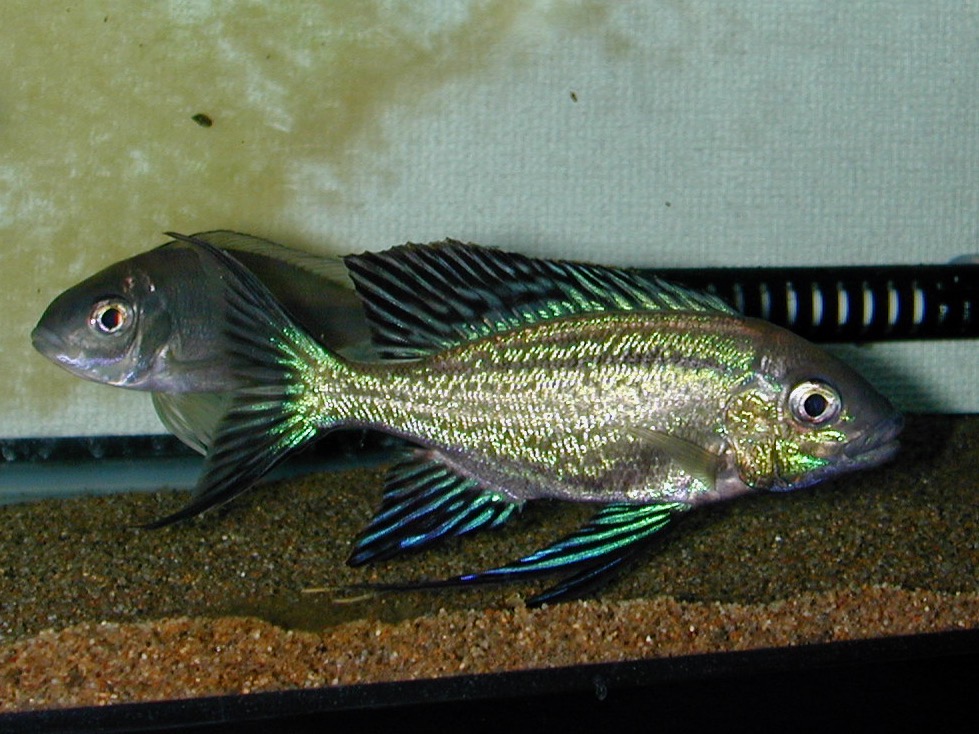キアソファリンクス・フォアイ "モリロ" 第2世代の繁殖記録
Breeding of Cyathopharynx foae "Moliro"

キアソファリンクス・フォアイ"モリロ"の稚魚 2004年6月
Fry of Cyathopharynx foae "Moliro", Jun. 2004
(このページは、新しい画像が下にあります。 Recent bottom.)
Cyathopharynx foae "Moliro"の繁殖に成功しました。マウスブルーダー(マウスブリーダー)であることは言うまでもありませんが、Cyathopharynx飼育の醍醐味は何と言ってもクレーターを作る独特の繁殖行動とそのときのオスの発色を見ることだと思います。
これより先にCyathopharynx foae "Mbita"のワイルド個体のペアからの繁殖を試みましたが、産卵はするものの食卵したりくわえなかったりで、結局成功していません。海外のサイトや洋書を見るとCyathopharynxのワイルド個体は、発色したオスであっても水槽飼育を始めると褪色してしまうことが多いが、ブリード個体は小さくして発色し腹ビレも伸びるとする記述が多くあります。そこで、ブリードものの幼魚数匹の群れから飼育を始めることにしました。マニアの方々はもう忘れてしまっていると思いますが、これは熱帯魚の入門書にあるシクリッド飼育の基本でもあります。C店(旧)に入荷した6cmのブリード幼魚の群れから6匹を選び、結局オス3・メス3となりました。発色しているオスは1匹のみです。(追記、その後3匹とも発色しました。)
Here I report the breeding of C. foae "Moliro".


クレーター内での産卵行動の様子。この写真は下に紹介したものとは別のとき(ずっと後)のものです。
Spawning within the crater-like nest. These photos were not taken at the time of breeding presented below but at later chances.

上は繁殖行動を繰り返している時期の水槽の様子です。右端にオスが作ったクレーターがあります。購入した幼魚は始めからこの水槽に導入しました。
Breeding tank. At the right corner, you can see the crater-like nest build by the fish.
飼育データ
水槽:120 x 45 x 45 cm(アクリル)
フィルター:上部式(水槽工房)、落水パイプにエルボーを付けているため、上の画像のクレーターの位置はあまり水流がありません。(この場所は餌を投入する穴の真下でもあります。)
ポンプ:レイシー P-112A、水槽やフィルターの大きさに対して流量はかなり少なく、現在はP-318Aに変更しています。
濾材:多孔質構造の業務用リング濾材、Mサイズ、20リットル。10キログラム(24リットル)で¥10,500の通販品。濾過槽の上部にはもちろんスポンジマットが入れてあります。
照明:なし。水槽は東向きの部屋の窓から約3メートル離れた位置の鉄架台の下段にあります。平日は深夜に1−2時間程度、土日は夕方から深夜まで部屋の蛍光灯が点きます。
底砂:サンディーゴールド(サモア)、5キログラム。最近タンガニイカシクリッドにこれを使う人が多いのではないでしょうか。かなり薄めに敷きましたが、魚は掻き集めてクレーターを作りました。
水温:冬23℃、夏28℃。
水質:人工湖水T/C (pH 8.5, GH 10) 活性炭浄水器を通した水道水 (pH 7.4, GH 5) 100リットル当たり、炭酸水素ナトリウム(重曹) 25グラム、塩化マグネシウム六水和物 12.5 グラム、塩化カリウム 3.1 グラム(全て食品添加物)を溶かしたもの。
換水:週1回、100リットル。スポンジマットも洗う。
餌:1日2回、朝と夜中(部屋の照明が点いたとき)。ひかりクレストグッピー、テトラベジタブル、セラグラニュグリーン、あゆソフト、ひかりマリーゴールドIなど。
Tank Data
Tank dimension: 120 x 45 x 45 cm.
Filter: Upper box with an 11 liter/min pump, containing 20 liters of ceramic rings.
Lighting: Indirect.
Substrate: Sandygold. I am not sure if this type of black sand is available in countries other than Japan. This sand contains vermiculite-like golden particles and sold as water plant sand.
Temperature: Basically 23 degree C, but 28 degree C in summer time.
Water conditioning: pH is adjusted to 8.5 by 0.25 gram/liter of sodium bicarbonate. GH (German definition) is raised up to 10 by magnesium chloride. (The tap water contains the almost equivalent concentration of calcium ion to Tanganyika lake water.) 0.06 gram/liter of potassium/sodium (1:1) chloride salt is also added.
Water change: Once in a week by 100 liter.
Feeding: Twice a day. Hikari Guppy, Tetra Vegetable Flake, Sera Granugreen, Nosan Ayu-soft (for industrial farming of sweetfish), Hikari Marigold (for goldfish).

飼育を初めて7ヵ月のある朝、1匹のメスが突然卵をくわえました。咽が膨らんでいます。全長10cm程とまだ小さいため予期していませんでした。
One morning in Jun. 2004, seven months after the start of keeping, I noticed that one female was keeping eggs in its mouth. That was unexpected because the fish was yet as small as 10 cm in total length.

この時点ではクレーターと言えるほどの構造はできておらず、ただ砂が帯状に掘られているだけでした。
At the first spawning, a steep nest crater was not built, but only a hollow was seen.

産卵後16日で稚魚を吐かせました。計8匹。多少は泳げるもののヨークサックはまだ大きく少し早すぎたようです。それでも、クリーンベビーブラインシュリンプやひかりパピィの稚魚用の餌を与えると食べています。
Sixteen days after the spawning, I took the fry. Eight babies came out. Though they still carry a big yolksack, they eat brineshrimps and small particles of dry food.

採仔後1週間の稚魚。もう自由に泳ぐことが出来ます。
A week later, the fry swim promptly.


初回の産卵から2−3日の間にオスは砂を掻き集めて立派なクレーターを作りました。
A steep crater appeared after the first spawning.

最初の産卵から約1週間後、別のメスが卵をくわえました。前回よりも咽の膨らみが大きいようです。
A week after the first spawning, another female laid eggs. More eggs were expected this time owing to the swelling throat.

きれいなクレーターができています。
A beautiful crater was used this time.

2回目は産卵から22日目に仔魚を採りました。17匹。十分に発生が進んでいましたが、今度は稚魚が自力で親魚の口内に残ろうとする力が強い(水中で親魚の口を開かせたとき、稚魚が奥に向かって泳ごうとする)ため、吐かせるのに苦労しました。
Seventeen fry were taken 22 days after the spawning. They were well developed and difficult to be taken out of the mother's mouth, because they tried vigorously to stay in the mouth.

1週間後。A week later.

その後も3匹のメスが順次産卵していますが、あまり殖やしても大変なので産卵当日に吐かせた卵です。物差しの目盛りは2mm間隔。色はトウモロコシそのものの黄色です。"Mbita"の卵はもう少しオレンジ掛かっていましたが、やはり黄色系の色です。この黄色はルティンというカロチノイドによるのではないでしょうか。これが卵の発生に必要なものなのか、たまたま黄色いだけなのかは判りませんが、この点が少し気になっていたので、ルティンを含むマリーゴールドが配合された餌(あゆソフト、ひかりマリーゴールド)を使ってみました。意味があるか否かは判りません。
Eggs just laid. Scale in 2 mm. After the two times of breeding, the females laid eggs repeatedly. As I had already noticed the yellow color of eggs of C. foae "Mbita" carried on another page, and as I guessed it to be a color of lutein, I feed them on foods (products for goldfish and sweetfish) containing marigold flower as a source of this carotenoid. Though I am not sure if it is effective for breeding of C. foae, Japanese researchers on fish farming reported that carotenoids are effective to produce eggs with high viability besides to improve yellow body color.


新しい水槽に稚魚を移しました。90 x 45 x 55 cm。砂はナイルサンド(ADA)にしてみました。
(以上、2004年6月の記録です。)
The fry were transferred into a new 90 x 45 x 55(H) cm tank. The bottom sand quarried and sold in Japan is named Nile Sand.


生後4ヵ月。野外で藻類を生やした植木鉢を入れるとつついています。
Four months after the birth. The fish pick algae on a flowerpot.

約6ヵ月。Six months.


約8ヵ月。8cm程度で既に数匹のオスの発色が始まり、クレーターも造りました。ナワバリ争いも始まっています。やはりブリードものは成熟が早い点でワイルドとは生理的に全く別物と考えた方がよいのでしょうか。
Eight months. Though even the biggest one is still as small as 8 cm in total length, some of them started getting color and building a nest. Aggression is also observed. Tank bred ones might be precocious.


約1年。底面を植木鉢で仕切るとクレーターが2つ出来ました。オスは日々入れ代わります。
One year. After I put flowerpots as screen, two craters were constructed. The occupying males change day by day.




約1年半。繁殖用の水槽へ。
One year and a half. Some of them were moved into a tank for breeding.


約2年。性比はオス3:メス1。オスは全て発色。2回で25匹採仔したうち成長不良の1匹と目のスレからポップアイを発症した1匹が死亡。他にも目の傷からポップアイを患った個体がいましたが、パラザンDを染み込ませた餌で完治しました。治療には1−2ヶ月かかりますが、早期に対処すれば治る場合が多いと思います。
Two years. The male/female ratio is 3 : 1. All males got their brilliant color. Two fish were lost during the two years.


生後満5年。大きいです。 Five years after the birth.